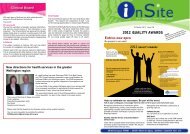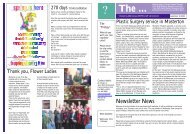Te Arawhata Totika - Wairarapa DHB
Te Arawhata Totika - Wairarapa DHB
Te Arawhata Totika - Wairarapa DHB
You also want an ePaper? Increase the reach of your titles
YUMPU automatically turns print PDFs into web optimized ePapers that Google loves.
<strong>Te</strong> ArA NAMuNAMu – hiSTOry<br />
Explains the path that all travel from the beginning of life<br />
Hauora – An historical Perspective<br />
The idea of a Cultural Competency Frame work is<br />
a relatively new concept for Mäori and also within<br />
the provision of health care. Mäori historically lived<br />
within an era of total indepen dence and maintained<br />
their own sovereignty in all aspects of their existence.<br />
unwellness was not deemed a cultural issue and<br />
nor was it necessary to develop Mäori models<br />
and frameworks to enhance wellbeing. Mäori<br />
wellness was a way of life that was just ordinary.<br />
Five key periods were identified within a historical<br />
context that ultimately influenced and shaped the<br />
hauora of Mäori people. A synopsis of these periods<br />
follows com mencing with the period prior to 1800<br />
and tracing its development to the present day. it<br />
provides an overview of the social and political events<br />
that influenced and shaped hauora in Aotearoa and<br />
some wairarapa examples are provided with the view<br />
that hauora has been subjected to interpretation,<br />
suppression, modi fication and renaissance over the<br />
past 200 years.<br />
Period 1: <strong>Te</strong> Wa Mäori<br />
The period prior to Colonisation –<br />
prior to 1800<br />
• Mäori lifestyle was based upon collective values<br />
and beliefs and founded with respective tikanga<br />
and kawa<br />
• Hauora existed within a balance of tapu and noa<br />
• Mäori healers and tohunga were products of<br />
traditional wananga teachings and learnings.<br />
They existed within specialist fields<br />
There was a body of knowledge that supported these<br />
practices and contributed to a sophisticated<br />
system of public health.<br />
in the wairarapa at this time the above applied.<br />
Leach and Leach, 1979, describes systems in place<br />
in the Palliser Bay region and <strong>Te</strong> whaiti has also<br />
described these in his presentations at <strong>Te</strong> Papa<br />
2002. history indicates that Mäori in the wairarapa<br />
practised hauora, and many of these practices<br />
have been captured in waiata and möteatea.<br />
Populations were located around marae and each<br />
marae was managed in a way that supported<br />
the tikanga established by tipuna. During this<br />
time hauora Mäori remained anchored and intact<br />
containing the values and the tikanga of the people<br />
and contributing to a social texture that provided<br />
an holistic approach to hauora or wellbeing.<br />
Period 2: A period of suppression and<br />
dispossession 1800–1900<br />
• Contact with early settlers supports new<br />
technology, trading opportunities and<br />
agri cultural benefits<br />
• The increasing number of immigrants disturbed<br />
the balance of power that was in exist ence<br />
and there were incidences of dis posession,<br />
destruction, disruption and imposi tion.<br />
• New illnesses, epidemics and a forced change<br />
in lifestyle imposed through colonis ation eroded<br />
systems and accepted societal struc tures and<br />
leadership. This contributed to the development<br />
of dis possessed Mäori com munities.<br />
• Mäori concepts of holistic health were replaced by<br />
western approaches to health care and result ed<br />
in episodic rather than continuing care.<br />
• The population collapse associated with<br />
colon isation was severe and was attributed<br />
to the dispossession of land and control of<br />
waterways, which not only served to make the<br />
people poor but made them more susceptible<br />
to diseases that flourish under conditions of<br />
poverty, overcrowding and malnutrition along<br />
with the introduction of alcohol and tobacco.<br />
• Social networks were disrupted leaving Mäori<br />
with limited practical and emotional support.<br />
This situation existed in the wairarapa and relates<br />
particularly to the loss of control of Lake wairarapa<br />
where the eeling industry was seriously compromised<br />
by the demands of the settlers. <strong>Te</strong> whaiti of Ngäti<br />
hinewaka demanded a return to the old ways. (1890)<br />
Period 3: The resurgence of<br />
Hauora Mäori 1900–1959<br />
During the 19th century hauora had experienced<br />
suppression along with much of the fabric of Mäori<br />
culture and society, and by the dawn of the 20th<br />
century only vestiges remained of the values-based<br />
system that existed before colonisation.<br />
<strong>Te</strong> <strong>Arawhata</strong> Tötika Cultural Competency Framework<br />
11







